Different Business Structures in Australia: Sole Trader, Partnership, Joint Venture, Trust, and Company
VerifiedAdded on 2023/06/11
|11
|2780
|308
AI Summary
This article discusses the different business structures in Australia including sole trader, partnership, joint venture, trust, and company. It also covers the director duties imposed by the Corporations Act, 2001 (Cth). The advantages and disadvantages of each business structure are explained in detail. The article also highlights the civil and criminal obligations imposed on directors under different sections of the Corporations Act, 2001 (Cth).
Contribute Materials
Your contribution can guide someone’s learning journey. Share your
documents today.
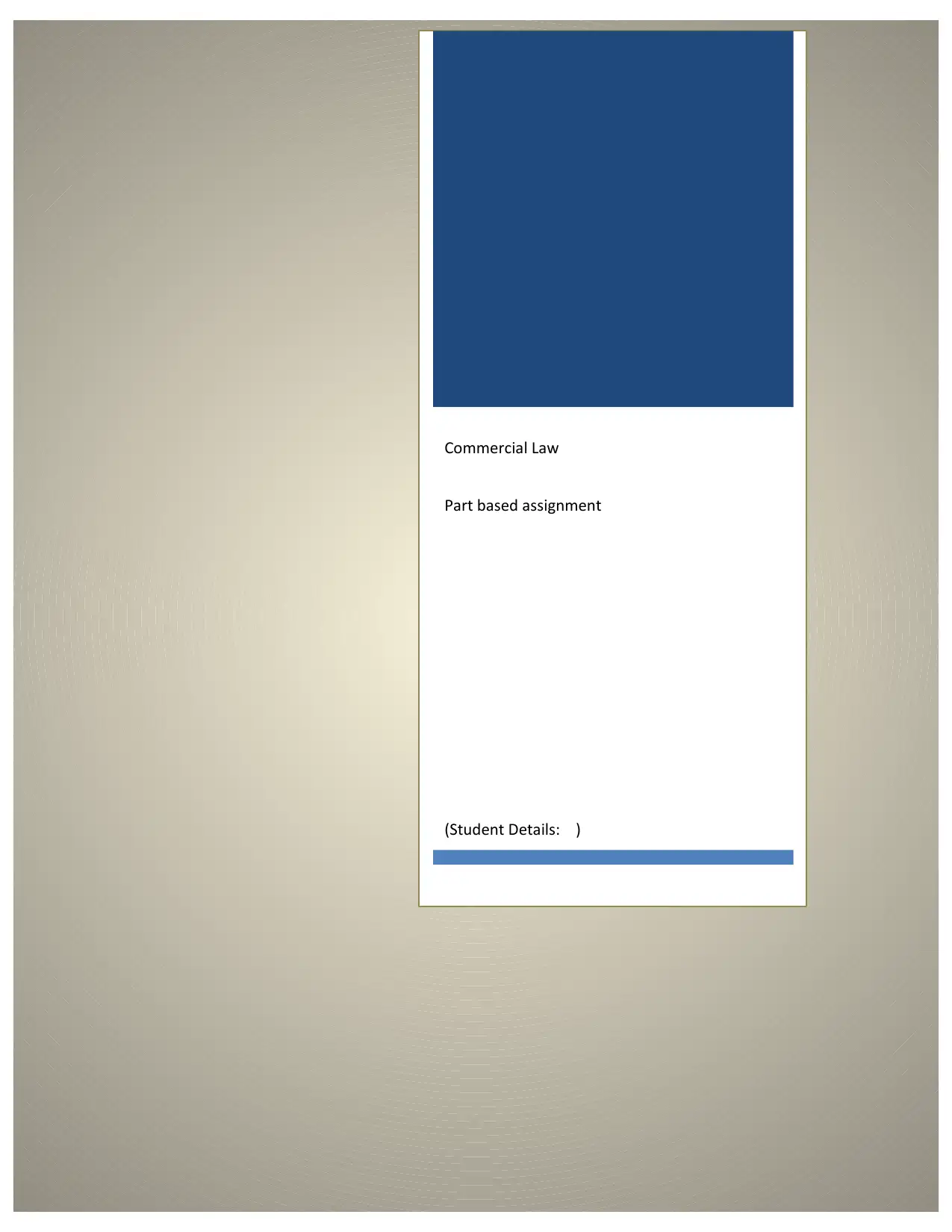
Commercial Law
Part based assignment
(Student Details: )
Part based assignment
(Student Details: )
Secure Best Marks with AI Grader
Need help grading? Try our AI Grader for instant feedback on your assignments.
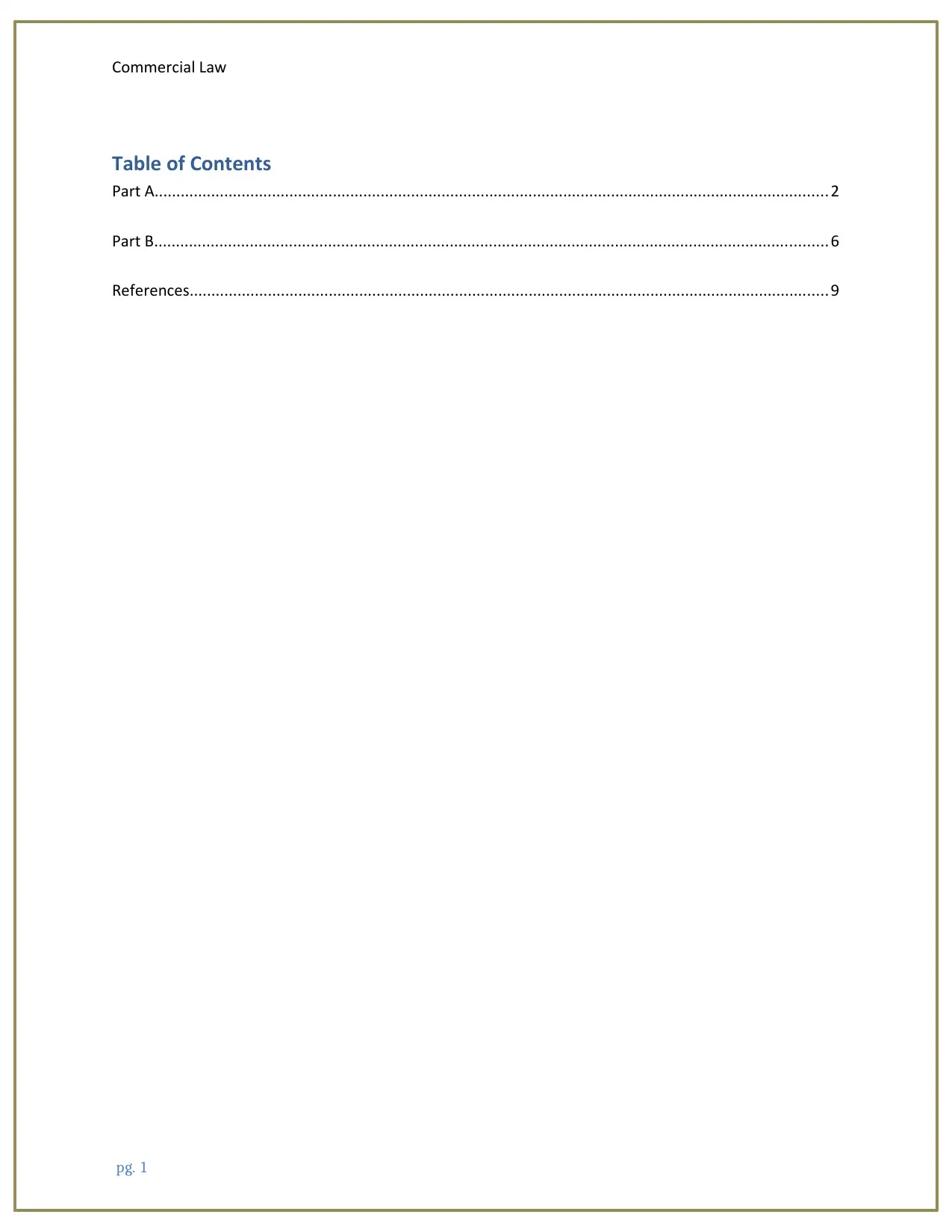
Commercial Law
Table of Contents
Part A...........................................................................................................................................................2
Part B...........................................................................................................................................................6
References...................................................................................................................................................9
pg. 1
Table of Contents
Part A...........................................................................................................................................................2
Part B...........................................................................................................................................................6
References...................................................................................................................................................9
pg. 1
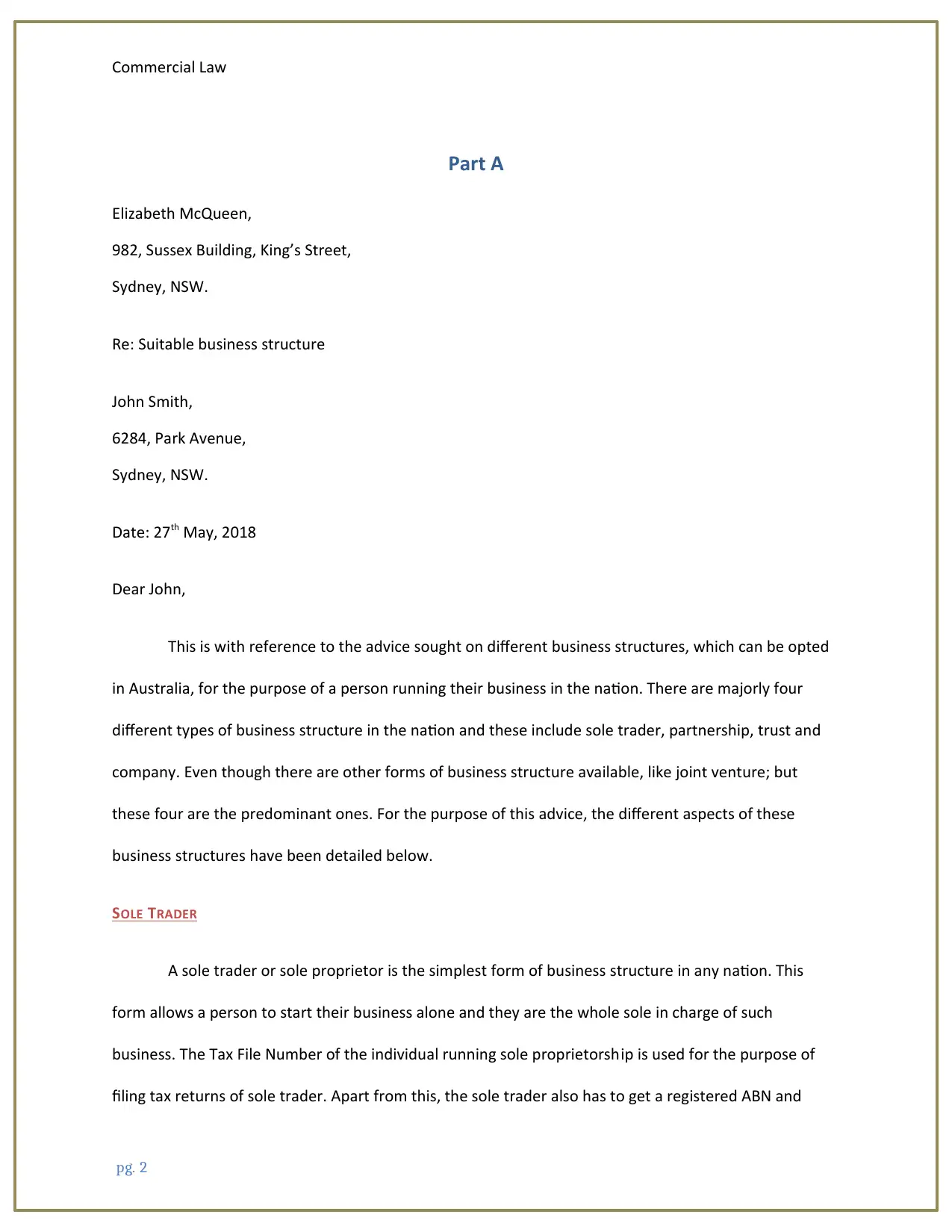
Commercial Law
Part A
Elizabeth McQueen,
982, Sussex Building, King’s Street,
Sydney, NSW.
Re: Suitable business structure
John Smith,
6284, Park Avenue,
Sydney, NSW.
Date: 27th May, 2018
Dear John,
This is with reference to the advice sought on different business structures, which can be opted
in Australia, for the purpose of a person running their business in the nation. There are majorly four
different types of business structure in the nation and these include sole trader, partnership, trust and
company. Even though there are other forms of business structure available, like joint venture; but
these four are the predominant ones. For the purpose of this advice, the different aspects of these
business structures have been detailed below.
SOLE TRADER
A sole trader or sole proprietor is the simplest form of business structure in any nation. This
form allows a person to start their business alone and they are the whole sole in charge of such
business. The Tax File Number of the individual running sole proprietorship is used for the purpose of
filing tax returns of sole trader. Apart from this, the sole trader also has to get a registered ABN and
pg. 2
Part A
Elizabeth McQueen,
982, Sussex Building, King’s Street,
Sydney, NSW.
Re: Suitable business structure
John Smith,
6284, Park Avenue,
Sydney, NSW.
Date: 27th May, 2018
Dear John,
This is with reference to the advice sought on different business structures, which can be opted
in Australia, for the purpose of a person running their business in the nation. There are majorly four
different types of business structure in the nation and these include sole trader, partnership, trust and
company. Even though there are other forms of business structure available, like joint venture; but
these four are the predominant ones. For the purpose of this advice, the different aspects of these
business structures have been detailed below.
SOLE TRADER
A sole trader or sole proprietor is the simplest form of business structure in any nation. This
form allows a person to start their business alone and they are the whole sole in charge of such
business. The Tax File Number of the individual running sole proprietorship is used for the purpose of
filing tax returns of sole trader. Apart from this, the sole trader also has to get a registered ABN and
pg. 2
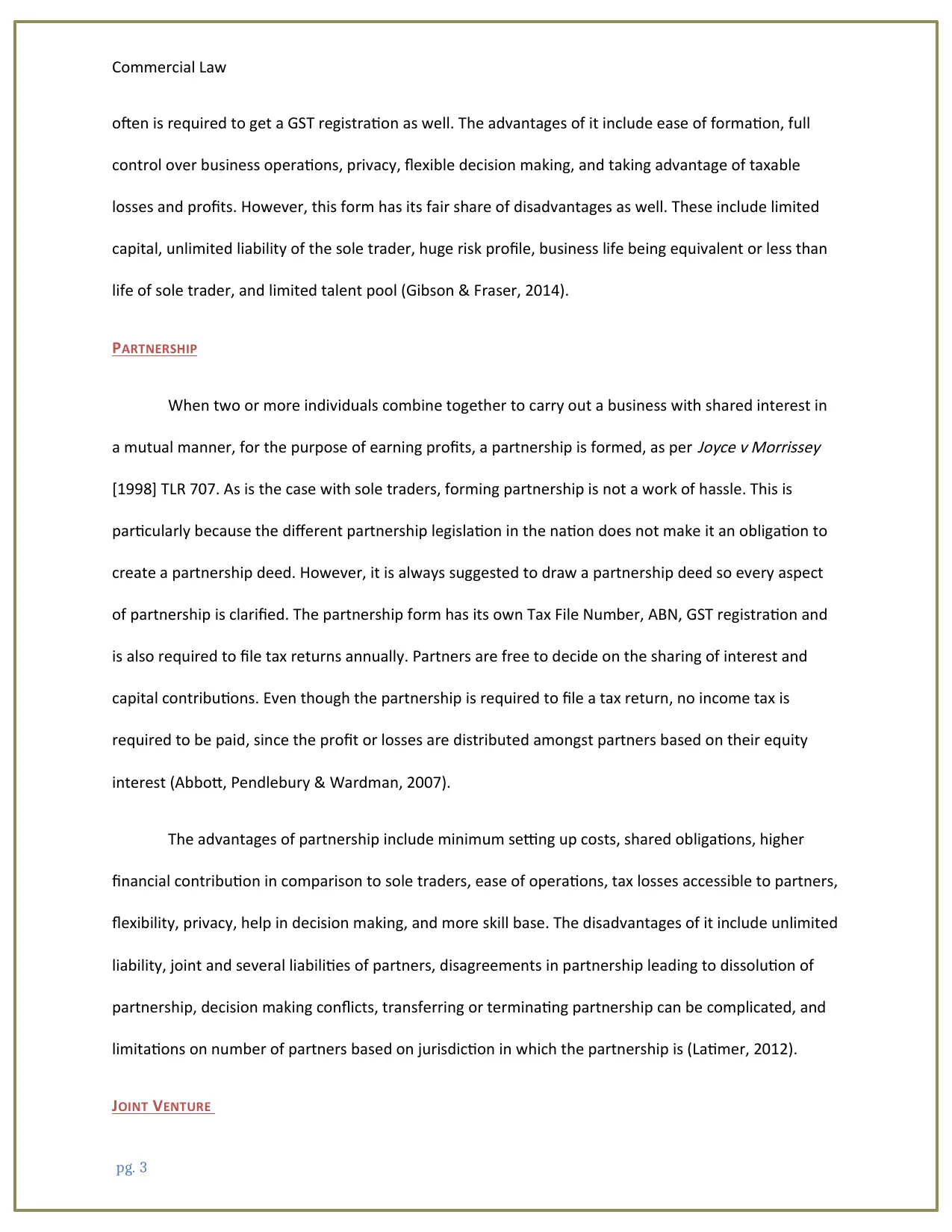
Commercial Law
often is required to get a GST registration as well. The advantages of it include ease of formation, full
control over business operations, privacy, flexible decision making, and taking advantage of taxable
losses and profits. However, this form has its fair share of disadvantages as well. These include limited
capital, unlimited liability of the sole trader, huge risk profile, business life being equivalent or less than
life of sole trader, and limited talent pool (Gibson & Fraser, 2014).
PARTNERSHIP
When two or more individuals combine together to carry out a business with shared interest in
a mutual manner, for the purpose of earning profits, a partnership is formed, as per
Joyce v Morrissey
[1998] TLR 707. As is the case with sole traders, forming partnership is not a work of hassle. This is
particularly because the different partnership legislation in the nation does not make it an obligation to
create a partnership deed. However, it is always suggested to draw a partnership deed so every aspect
of partnership is clarified. The partnership form has its own Tax File Number, ABN, GST registration and
is also required to file tax returns annually. Partners are free to decide on the sharing of interest and
capital contributions. Even though the partnership is required to file a tax return, no income tax is
required to be paid, since the profit or losses are distributed amongst partners based on their equity
interest (Abbott, Pendlebury & Wardman, 2007).
The advantages of partnership include minimum setting up costs, shared obligations, higher
financial contribution in comparison to sole traders, ease of operations, tax losses accessible to partners,
flexibility, privacy, help in decision making, and more skill base. The disadvantages of it include unlimited
liability, joint and several liabilities of partners, disagreements in partnership leading to dissolution of
partnership, decision making conflicts, transferring or terminating partnership can be complicated, and
limitations on number of partners based on jurisdiction in which the partnership is (Latimer, 2012).
JOINT VENTURE
pg. 3
often is required to get a GST registration as well. The advantages of it include ease of formation, full
control over business operations, privacy, flexible decision making, and taking advantage of taxable
losses and profits. However, this form has its fair share of disadvantages as well. These include limited
capital, unlimited liability of the sole trader, huge risk profile, business life being equivalent or less than
life of sole trader, and limited talent pool (Gibson & Fraser, 2014).
PARTNERSHIP
When two or more individuals combine together to carry out a business with shared interest in
a mutual manner, for the purpose of earning profits, a partnership is formed, as per
Joyce v Morrissey
[1998] TLR 707. As is the case with sole traders, forming partnership is not a work of hassle. This is
particularly because the different partnership legislation in the nation does not make it an obligation to
create a partnership deed. However, it is always suggested to draw a partnership deed so every aspect
of partnership is clarified. The partnership form has its own Tax File Number, ABN, GST registration and
is also required to file tax returns annually. Partners are free to decide on the sharing of interest and
capital contributions. Even though the partnership is required to file a tax return, no income tax is
required to be paid, since the profit or losses are distributed amongst partners based on their equity
interest (Abbott, Pendlebury & Wardman, 2007).
The advantages of partnership include minimum setting up costs, shared obligations, higher
financial contribution in comparison to sole traders, ease of operations, tax losses accessible to partners,
flexibility, privacy, help in decision making, and more skill base. The disadvantages of it include unlimited
liability, joint and several liabilities of partners, disagreements in partnership leading to dissolution of
partnership, decision making conflicts, transferring or terminating partnership can be complicated, and
limitations on number of partners based on jurisdiction in which the partnership is (Latimer, 2012).
JOINT VENTURE
pg. 3
Secure Best Marks with AI Grader
Need help grading? Try our AI Grader for instant feedback on your assignments.
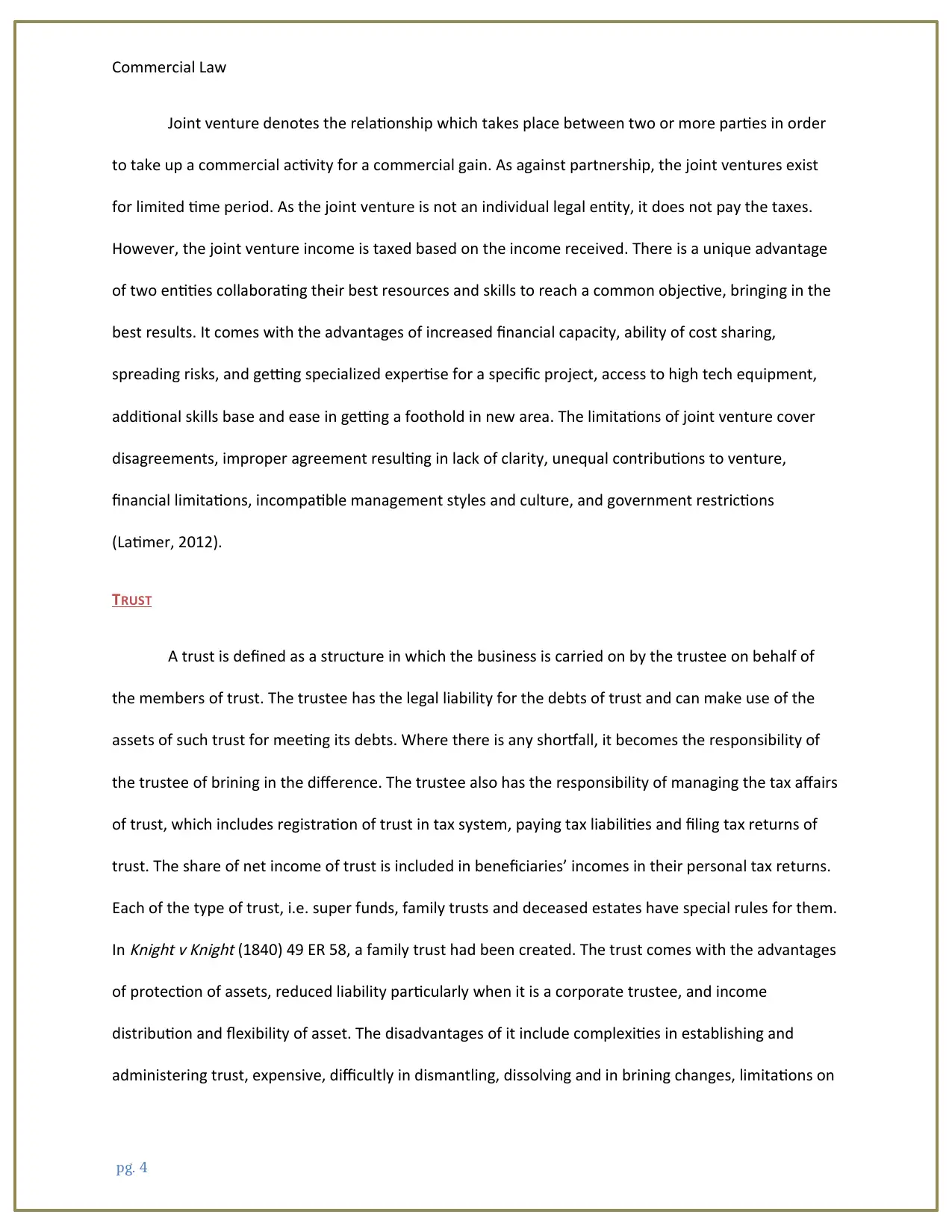
Commercial Law
Joint venture denotes the relationship which takes place between two or more parties in order
to take up a commercial activity for a commercial gain. As against partnership, the joint ventures exist
for limited time period. As the joint venture is not an individual legal entity, it does not pay the taxes.
However, the joint venture income is taxed based on the income received. There is a unique advantage
of two entities collaborating their best resources and skills to reach a common objective, bringing in the
best results. It comes with the advantages of increased financial capacity, ability of cost sharing,
spreading risks, and getting specialized expertise for a specific project, access to high tech equipment,
additional skills base and ease in getting a foothold in new area. The limitations of joint venture cover
disagreements, improper agreement resulting in lack of clarity, unequal contributions to venture,
financial limitations, incompatible management styles and culture, and government restrictions
(Latimer, 2012).
TRUST
A trust is defined as a structure in which the business is carried on by the trustee on behalf of
the members of trust. The trustee has the legal liability for the debts of trust and can make use of the
assets of such trust for meeting its debts. Where there is any shortfall, it becomes the responsibility of
the trustee of brining in the difference. The trustee also has the responsibility of managing the tax affairs
of trust, which includes registration of trust in tax system, paying tax liabilities and filing tax returns of
trust. The share of net income of trust is included in beneficiaries’ incomes in their personal tax returns.
Each of the type of trust, i.e. super funds, family trusts and deceased estates have special rules for them.
In
Knight v Knight (1840) 49 ER 58, a family trust had been created. The trust comes with the advantages
of protection of assets, reduced liability particularly when it is a corporate trustee, and income
distribution and flexibility of asset. The disadvantages of it include complexities in establishing and
administering trust, expensive, difficultly in dismantling, dissolving and in brining changes, limitations on
pg. 4
Joint venture denotes the relationship which takes place between two or more parties in order
to take up a commercial activity for a commercial gain. As against partnership, the joint ventures exist
for limited time period. As the joint venture is not an individual legal entity, it does not pay the taxes.
However, the joint venture income is taxed based on the income received. There is a unique advantage
of two entities collaborating their best resources and skills to reach a common objective, bringing in the
best results. It comes with the advantages of increased financial capacity, ability of cost sharing,
spreading risks, and getting specialized expertise for a specific project, access to high tech equipment,
additional skills base and ease in getting a foothold in new area. The limitations of joint venture cover
disagreements, improper agreement resulting in lack of clarity, unequal contributions to venture,
financial limitations, incompatible management styles and culture, and government restrictions
(Latimer, 2012).
TRUST
A trust is defined as a structure in which the business is carried on by the trustee on behalf of
the members of trust. The trustee has the legal liability for the debts of trust and can make use of the
assets of such trust for meeting its debts. Where there is any shortfall, it becomes the responsibility of
the trustee of brining in the difference. The trustee also has the responsibility of managing the tax affairs
of trust, which includes registration of trust in tax system, paying tax liabilities and filing tax returns of
trust. The share of net income of trust is included in beneficiaries’ incomes in their personal tax returns.
Each of the type of trust, i.e. super funds, family trusts and deceased estates have special rules for them.
In
Knight v Knight (1840) 49 ER 58, a family trust had been created. The trust comes with the advantages
of protection of assets, reduced liability particularly when it is a corporate trustee, and income
distribution and flexibility of asset. The disadvantages of it include complexities in establishing and
administering trust, expensive, difficultly in dismantling, dissolving and in brining changes, limitations on
pg. 4
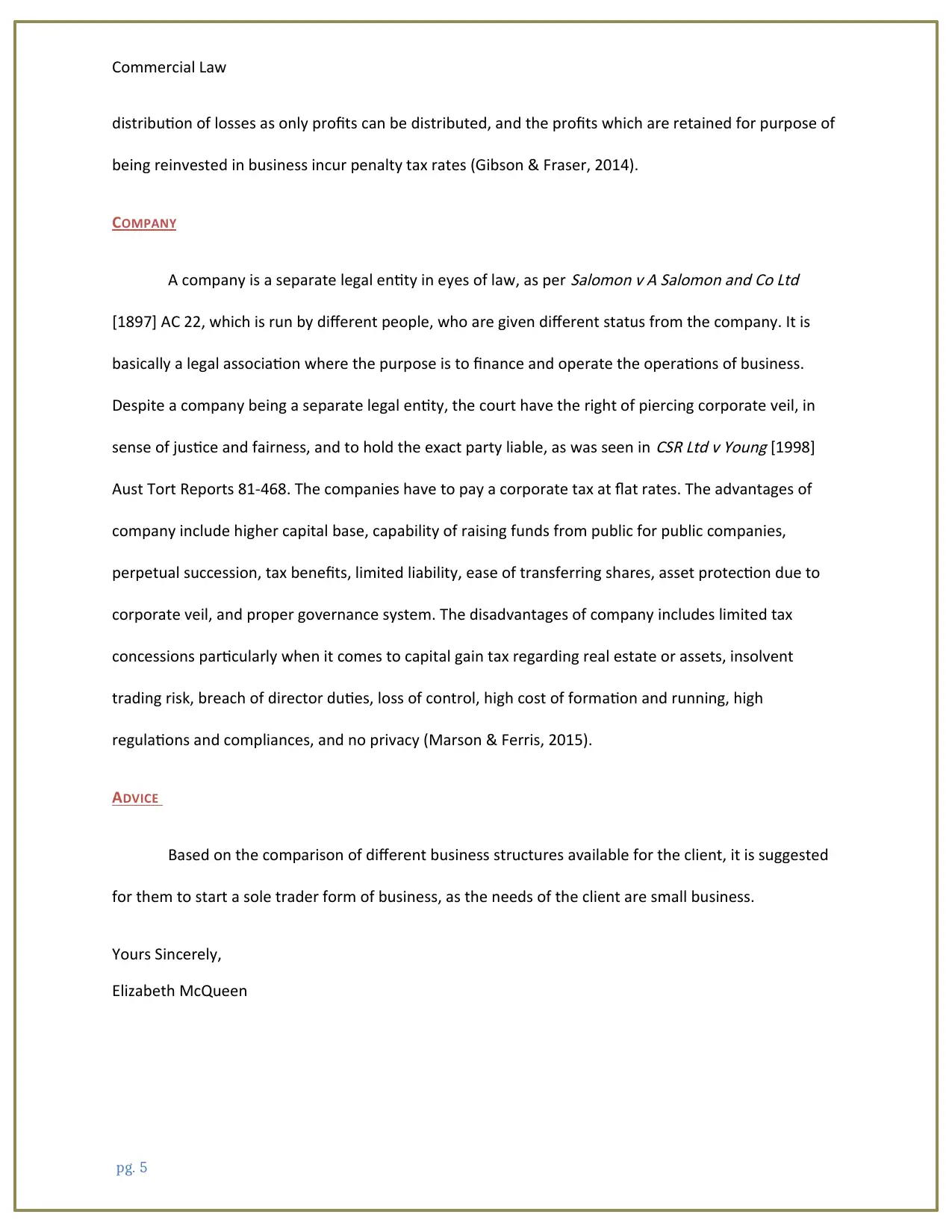
Commercial Law
distribution of losses as only profits can be distributed, and the profits which are retained for purpose of
being reinvested in business incur penalty tax rates (Gibson & Fraser, 2014).
COMPANY
A company is a separate legal entity in eyes of law, as per
Salomon v A Salomon and Co Ltd
[1897] AC 22, which is run by different people, who are given different status from the company. It is
basically a legal association where the purpose is to finance and operate the operations of business.
Despite a company being a separate legal entity, the court have the right of piercing corporate veil, in
sense of justice and fairness, and to hold the exact party liable, as was seen in
CSR Ltd v Young [1998]
Aust Tort Reports 81-468. The companies have to pay a corporate tax at flat rates. The advantages of
company include higher capital base, capability of raising funds from public for public companies,
perpetual succession, tax benefits, limited liability, ease of transferring shares, asset protection due to
corporate veil, and proper governance system. The disadvantages of company includes limited tax
concessions particularly when it comes to capital gain tax regarding real estate or assets, insolvent
trading risk, breach of director duties, loss of control, high cost of formation and running, high
regulations and compliances, and no privacy (Marson & Ferris, 2015).
ADVICE
Based on the comparison of different business structures available for the client, it is suggested
for them to start a sole trader form of business, as the needs of the client are small business.
Yours Sincerely,
Elizabeth McQueen
pg. 5
distribution of losses as only profits can be distributed, and the profits which are retained for purpose of
being reinvested in business incur penalty tax rates (Gibson & Fraser, 2014).
COMPANY
A company is a separate legal entity in eyes of law, as per
Salomon v A Salomon and Co Ltd
[1897] AC 22, which is run by different people, who are given different status from the company. It is
basically a legal association where the purpose is to finance and operate the operations of business.
Despite a company being a separate legal entity, the court have the right of piercing corporate veil, in
sense of justice and fairness, and to hold the exact party liable, as was seen in
CSR Ltd v Young [1998]
Aust Tort Reports 81-468. The companies have to pay a corporate tax at flat rates. The advantages of
company include higher capital base, capability of raising funds from public for public companies,
perpetual succession, tax benefits, limited liability, ease of transferring shares, asset protection due to
corporate veil, and proper governance system. The disadvantages of company includes limited tax
concessions particularly when it comes to capital gain tax regarding real estate or assets, insolvent
trading risk, breach of director duties, loss of control, high cost of formation and running, high
regulations and compliances, and no privacy (Marson & Ferris, 2015).
ADVICE
Based on the comparison of different business structures available for the client, it is suggested
for them to start a sole trader form of business, as the needs of the client are small business.
Yours Sincerely,
Elizabeth McQueen
pg. 5

Commercial Law
Part B
Directors are the individuals who run the business operations of the company on behalf of the
shareholders. Due to the magnitude of work given to them, they are imposed with certain duties. These
duties are covered under both common law and statutory law. The crux of both these laws, in terms of
the imposed duties is similar and this discussion is focused on the director duties as have been covered
under the statutory law of the nation (Cassidy, 2006). The Corporations Act, 2001 (Cth) is the legislation
which applies on all the companies in Australia. This legislation, through its Part 2D.1 specifically covers
director duties, and some other duties of directors are also covered under different segments (Plessis &
Koker, 2017). Some of these duties have been covered below.
Section 180: This section imposes a civil obligation on the directors of undertaking their work in
a careful and diligent manner. This section provides that a director has to use their powers and
discharge their duties as a reasonable person would do, had such a reasonable person been the
director of the company, had same responsibilities as the director and was faced with the same
situations as the director of this company, as had been proved through
Statewide Tobacco
Services Ltd v Morley (1990) 2 ACSR 405.
Section 181: This section imposes a civil obligation on the directors regarding undertaking their
work for proper purpose, in good faith and in best interest of the company. This has to be done
while the director uses their powers and discharges their duties. The leading example of this
section being breached is
Asic v Adler and 4 Ors [2002] NSWSC 171.
Section 182: This section imposes a civil obligation on the directors regarding not making an
improper use of their position while the director uses their powers and discharges their duties.
The leading example of this section being breached is
R v Byrnes (1995) 130 ALR 529.
pg. 6
Part B
Directors are the individuals who run the business operations of the company on behalf of the
shareholders. Due to the magnitude of work given to them, they are imposed with certain duties. These
duties are covered under both common law and statutory law. The crux of both these laws, in terms of
the imposed duties is similar and this discussion is focused on the director duties as have been covered
under the statutory law of the nation (Cassidy, 2006). The Corporations Act, 2001 (Cth) is the legislation
which applies on all the companies in Australia. This legislation, through its Part 2D.1 specifically covers
director duties, and some other duties of directors are also covered under different segments (Plessis &
Koker, 2017). Some of these duties have been covered below.
Section 180: This section imposes a civil obligation on the directors of undertaking their work in
a careful and diligent manner. This section provides that a director has to use their powers and
discharge their duties as a reasonable person would do, had such a reasonable person been the
director of the company, had same responsibilities as the director and was faced with the same
situations as the director of this company, as had been proved through
Statewide Tobacco
Services Ltd v Morley (1990) 2 ACSR 405.
Section 181: This section imposes a civil obligation on the directors regarding undertaking their
work for proper purpose, in good faith and in best interest of the company. This has to be done
while the director uses their powers and discharges their duties. The leading example of this
section being breached is
Asic v Adler and 4 Ors [2002] NSWSC 171.
Section 182: This section imposes a civil obligation on the directors regarding not making an
improper use of their position while the director uses their powers and discharges their duties.
The leading example of this section being breached is
R v Byrnes (1995) 130 ALR 529.
pg. 6
Paraphrase This Document
Need a fresh take? Get an instant paraphrase of this document with our AI Paraphraser
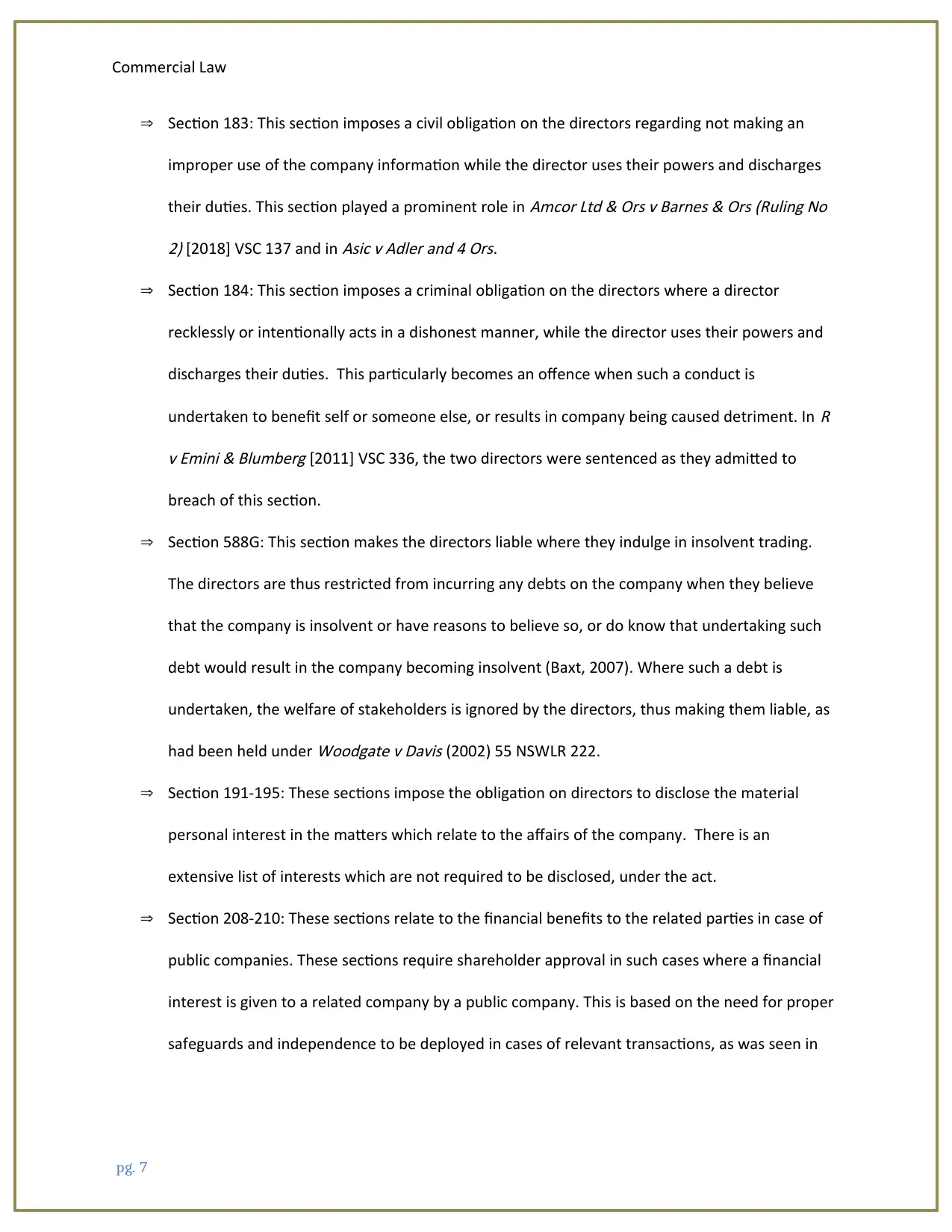
Commercial Law
Section 183: This section imposes a civil obligation on the directors regarding not making an
improper use of the company information while the director uses their powers and discharges
their duties. This section played a prominent role in
Amcor Ltd & Ors v Barnes & Ors (Ruling No
2) [2018] VSC 137 and in
Asic v Adler and 4 Ors.
Section 184: This section imposes a criminal obligation on the directors where a director
recklessly or intentionally acts in a dishonest manner, while the director uses their powers and
discharges their duties. This particularly becomes an offence when such a conduct is
undertaken to benefit self or someone else, or results in company being caused detriment. In
R
v Emini & Blumberg [2011] VSC 336, the two directors were sentenced as they admitted to
breach of this section.
Section 588G: This section makes the directors liable where they indulge in insolvent trading.
The directors are thus restricted from incurring any debts on the company when they believe
that the company is insolvent or have reasons to believe so, or do know that undertaking such
debt would result in the company becoming insolvent (Baxt, 2007). Where such a debt is
undertaken, the welfare of stakeholders is ignored by the directors, thus making them liable, as
had been held under
Woodgate v Davis (2002) 55 NSWLR 222.
Section 191-195: These sections impose the obligation on directors to disclose the material
personal interest in the matters which relate to the affairs of the company. There is an
extensive list of interests which are not required to be disclosed, under the act.
Section 208-210: These sections relate to the financial benefits to the related parties in case of
public companies. These sections require shareholder approval in such cases where a financial
interest is given to a related company by a public company. This is based on the need for proper
safeguards and independence to be deployed in cases of relevant transactions, as was seen in
pg. 7
Section 183: This section imposes a civil obligation on the directors regarding not making an
improper use of the company information while the director uses their powers and discharges
their duties. This section played a prominent role in
Amcor Ltd & Ors v Barnes & Ors (Ruling No
2) [2018] VSC 137 and in
Asic v Adler and 4 Ors.
Section 184: This section imposes a criminal obligation on the directors where a director
recklessly or intentionally acts in a dishonest manner, while the director uses their powers and
discharges their duties. This particularly becomes an offence when such a conduct is
undertaken to benefit self or someone else, or results in company being caused detriment. In
R
v Emini & Blumberg [2011] VSC 336, the two directors were sentenced as they admitted to
breach of this section.
Section 588G: This section makes the directors liable where they indulge in insolvent trading.
The directors are thus restricted from incurring any debts on the company when they believe
that the company is insolvent or have reasons to believe so, or do know that undertaking such
debt would result in the company becoming insolvent (Baxt, 2007). Where such a debt is
undertaken, the welfare of stakeholders is ignored by the directors, thus making them liable, as
had been held under
Woodgate v Davis (2002) 55 NSWLR 222.
Section 191-195: These sections impose the obligation on directors to disclose the material
personal interest in the matters which relate to the affairs of the company. There is an
extensive list of interests which are not required to be disclosed, under the act.
Section 208-210: These sections relate to the financial benefits to the related parties in case of
public companies. These sections require shareholder approval in such cases where a financial
interest is given to a related company by a public company. This is based on the need for proper
safeguards and independence to be deployed in cases of relevant transactions, as was seen in
pg. 7
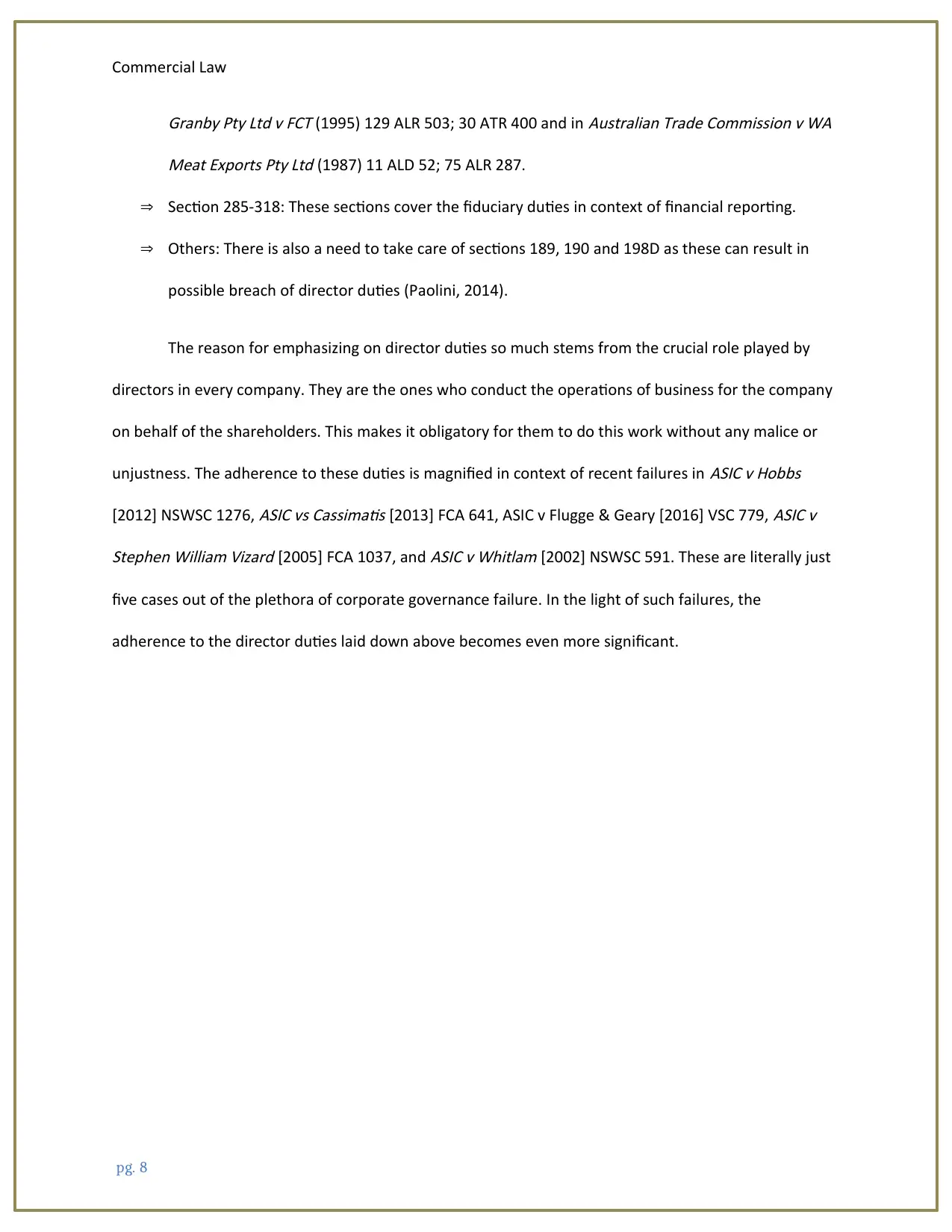
Commercial Law
Granby Pty Ltd v FCT (1995) 129 ALR 503; 30 ATR 400 and in
Australian Trade Commission v WA
Meat Exports Pty Ltd (1987) 11 ALD 52; 75 ALR 287.
Section 285-318: These sections cover the fiduciary duties in context of financial reporting.
Others: There is also a need to take care of sections 189, 190 and 198D as these can result in
possible breach of director duties (Paolini, 2014).
The reason for emphasizing on director duties so much stems from the crucial role played by
directors in every company. They are the ones who conduct the operations of business for the company
on behalf of the shareholders. This makes it obligatory for them to do this work without any malice or
unjustness. The adherence to these duties is magnified in context of recent failures in
ASIC v Hobbs
[2012] NSWSC 1276,
ASIC vs Cassimatis [2013] FCA 641, ASIC v Flugge & Geary [2016] VSC 779,
ASIC v
Stephen William Vizard [2005] FCA 1037, and
ASIC v Whitlam [2002] NSWSC 591. These are literally just
five cases out of the plethora of corporate governance failure. In the light of such failures, the
adherence to the director duties laid down above becomes even more significant.
pg. 8
Granby Pty Ltd v FCT (1995) 129 ALR 503; 30 ATR 400 and in
Australian Trade Commission v WA
Meat Exports Pty Ltd (1987) 11 ALD 52; 75 ALR 287.
Section 285-318: These sections cover the fiduciary duties in context of financial reporting.
Others: There is also a need to take care of sections 189, 190 and 198D as these can result in
possible breach of director duties (Paolini, 2014).
The reason for emphasizing on director duties so much stems from the crucial role played by
directors in every company. They are the ones who conduct the operations of business for the company
on behalf of the shareholders. This makes it obligatory for them to do this work without any malice or
unjustness. The adherence to these duties is magnified in context of recent failures in
ASIC v Hobbs
[2012] NSWSC 1276,
ASIC vs Cassimatis [2013] FCA 641, ASIC v Flugge & Geary [2016] VSC 779,
ASIC v
Stephen William Vizard [2005] FCA 1037, and
ASIC v Whitlam [2002] NSWSC 591. These are literally just
five cases out of the plethora of corporate governance failure. In the light of such failures, the
adherence to the director duties laid down above becomes even more significant.
pg. 8
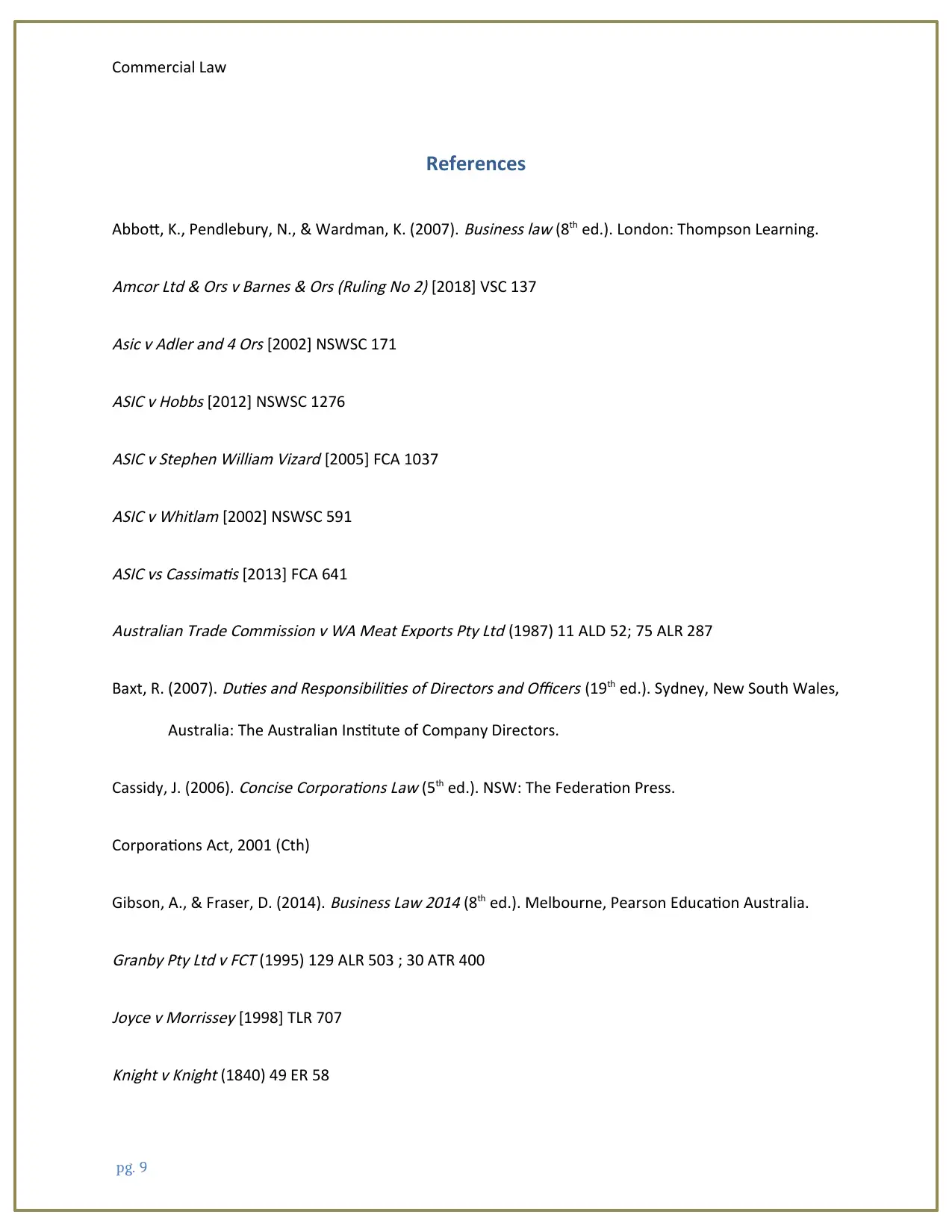
Commercial Law
References
Abbott, K., Pendlebury, N., & Wardman, K. (2007).
Business law (8th ed.). London: Thompson Learning.
Amcor Ltd & Ors v Barnes & Ors (Ruling No 2) [2018] VSC 137
Asic v Adler and 4 Ors [2002] NSWSC 171
ASIC v Hobbs [2012] NSWSC 1276
ASIC v Stephen William Vizard [2005] FCA 1037
ASIC v Whitlam [2002] NSWSC 591
ASIC vs Cassimatis [2013] FCA 641
Australian Trade Commission v WA Meat Exports Pty Ltd (1987) 11 ALD 52; 75 ALR 287
Baxt, R. (2007).
Duties and Responsibilities of Directors and Officers (19th ed.). Sydney, New South Wales,
Australia: The Australian Institute of Company Directors.
Cassidy, J. (2006).
Concise Corporations Law (5th ed.). NSW: The Federation Press.
Corporations Act, 2001 (Cth)
Gibson, A., & Fraser, D. (2014).
Business Law 2014 (8th ed.). Melbourne, Pearson Education Australia.
Granby Pty Ltd v FCT (1995) 129 ALR 503 ; 30 ATR 400
Joyce v Morrissey [1998] TLR 707
Knight v Knight (1840) 49 ER 58
pg. 9
References
Abbott, K., Pendlebury, N., & Wardman, K. (2007).
Business law (8th ed.). London: Thompson Learning.
Amcor Ltd & Ors v Barnes & Ors (Ruling No 2) [2018] VSC 137
Asic v Adler and 4 Ors [2002] NSWSC 171
ASIC v Hobbs [2012] NSWSC 1276
ASIC v Stephen William Vizard [2005] FCA 1037
ASIC v Whitlam [2002] NSWSC 591
ASIC vs Cassimatis [2013] FCA 641
Australian Trade Commission v WA Meat Exports Pty Ltd (1987) 11 ALD 52; 75 ALR 287
Baxt, R. (2007).
Duties and Responsibilities of Directors and Officers (19th ed.). Sydney, New South Wales,
Australia: The Australian Institute of Company Directors.
Cassidy, J. (2006).
Concise Corporations Law (5th ed.). NSW: The Federation Press.
Corporations Act, 2001 (Cth)
Gibson, A., & Fraser, D. (2014).
Business Law 2014 (8th ed.). Melbourne, Pearson Education Australia.
Granby Pty Ltd v FCT (1995) 129 ALR 503 ; 30 ATR 400
Joyce v Morrissey [1998] TLR 707
Knight v Knight (1840) 49 ER 58
pg. 9
Secure Best Marks with AI Grader
Need help grading? Try our AI Grader for instant feedback on your assignments.
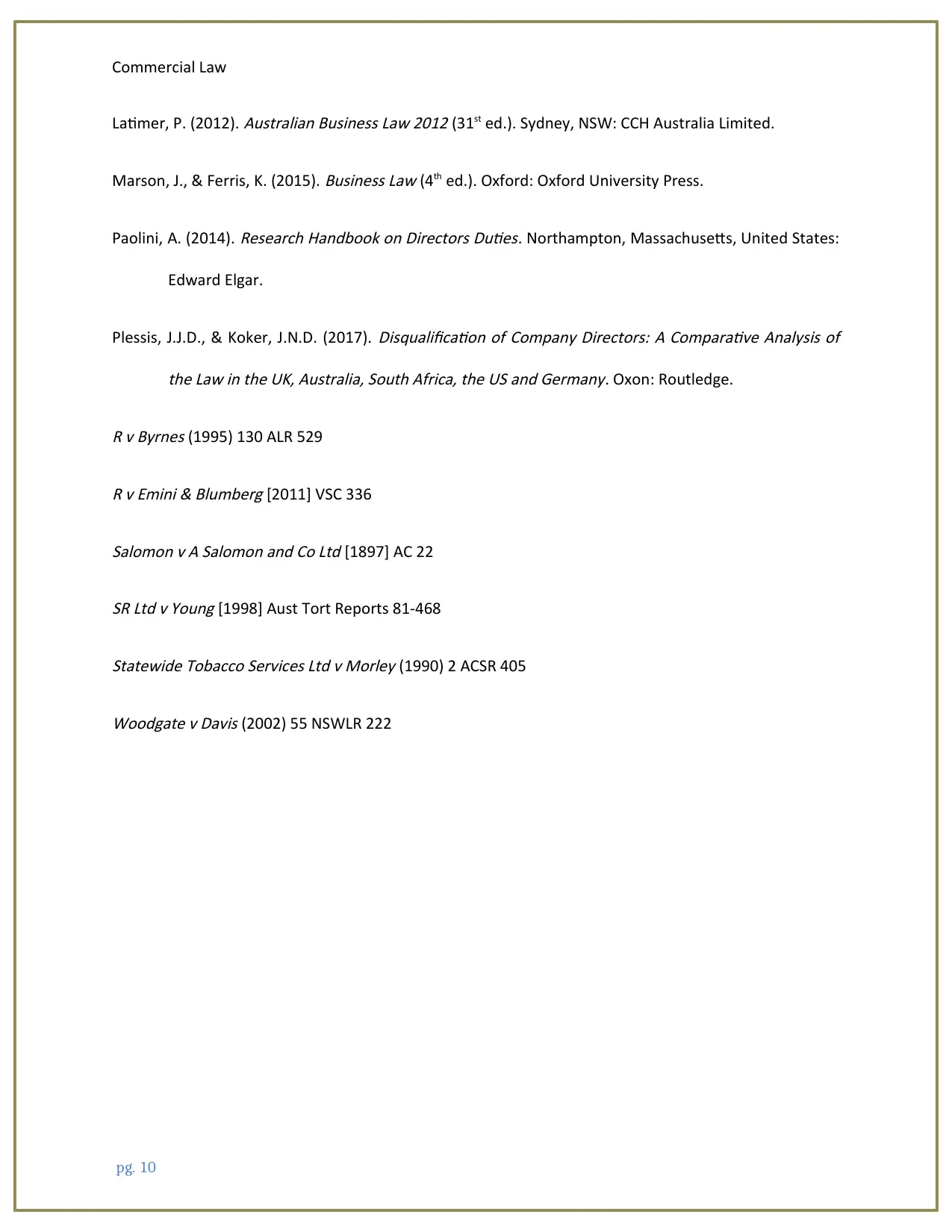
Commercial Law
Latimer, P. (2012).
Australian Business Law 2012 (31st ed.). Sydney, NSW: CCH Australia Limited.
Marson, J., & Ferris, K. (2015).
Business Law (4th ed.). Oxford: Oxford University Press.
Paolini, A. (2014).
Research Handbook on Directors Duties. Northampton, Massachusetts, United States:
Edward Elgar.
Plessis, J.J.D., & Koker, J.N.D. (2017).
Disqualification of Company Directors: A Comparative Analysis of
the Law in the UK, Australia, South Africa, the US and Germany. Oxon: Routledge.
R v Byrnes (1995) 130 ALR 529
R v Emini & Blumberg [2011] VSC 336
Salomon v A Salomon and Co Ltd [1897] AC 22
SR Ltd v Young [1998] Aust Tort Reports 81-468
Statewide Tobacco Services Ltd v Morley (1990) 2 ACSR 405
Woodgate v Davis (2002) 55 NSWLR 222
pg. 10
Latimer, P. (2012).
Australian Business Law 2012 (31st ed.). Sydney, NSW: CCH Australia Limited.
Marson, J., & Ferris, K. (2015).
Business Law (4th ed.). Oxford: Oxford University Press.
Paolini, A. (2014).
Research Handbook on Directors Duties. Northampton, Massachusetts, United States:
Edward Elgar.
Plessis, J.J.D., & Koker, J.N.D. (2017).
Disqualification of Company Directors: A Comparative Analysis of
the Law in the UK, Australia, South Africa, the US and Germany. Oxon: Routledge.
R v Byrnes (1995) 130 ALR 529
R v Emini & Blumberg [2011] VSC 336
Salomon v A Salomon and Co Ltd [1897] AC 22
SR Ltd v Young [1998] Aust Tort Reports 81-468
Statewide Tobacco Services Ltd v Morley (1990) 2 ACSR 405
Woodgate v Davis (2002) 55 NSWLR 222
pg. 10
1 out of 11
Related Documents
Your All-in-One AI-Powered Toolkit for Academic Success.
+13062052269
info@desklib.com
Available 24*7 on WhatsApp / Email
![[object Object]](/_next/static/media/star-bottom.7253800d.svg)
Unlock your academic potential
© 2024 | Zucol Services PVT LTD | All rights reserved.


